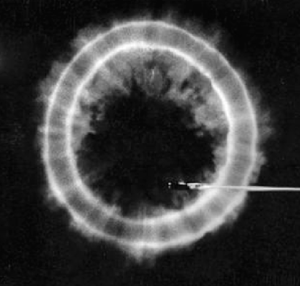Calculation method of electromagnetic waves scattering by dielectric toroid meteorological formations
DOI:
https://doi.org/10.3103/S0735272720110047Keywords:
calculation method, discrete reflection, meteorological formation, vortex ring, scattering diagram, electromagnetic wave, effective scattering areaAbstract
One of the possible physical mechanisms of so-called “angel” echoes, not visually observed radar discrete reflections from objects, is considered. The vortex flows can be the cause of “angel” echoes. They take out some volume of air with certain radiophysical parameters into the region of space with other radiophysical parameters of the air. Toroidal vortices (vortex rings) have a fairly long lifetime and can move to considerable distances without destruction. The calculation of radio wave scattering diagrams by vortex rings by modern universal programs designed to solve electrodynamic problems and based on the method of moments requires significant computational and time resources. The asymptotic calculation method of the electromagnetic waves scattering by dielectric toroidal formations of large radius is developed. Simulation and comparison of its results with calculations in Altair Feko is carried out, and their well coincidence is shown. The monostatic and bistatic effective scattering areas of vortex rings are calculated for interesting cases in practice. The calculation results for the monostatic location good enough coincide with the results of known experimental works.References
- N. L. Byzova, V. N. Ivanov, Е. K. Garger, Turbulence in Atmospheric Boundary Layer, [in Russian]. Leningrad: Hydrometeoizdat, 1989.
- R. ITU, Handbook on Radiometeorology. ITU, 2014, uri: https://www.itu.int/dms_pub/itu-r/opb/hdb/R-HDB-26-2013-OAS-PDF-E.pdf.
- А. А. Chernikov, Radar Reflections from Clear Sky, [in Russian]. Leningrad: Hydrometeoizdat, 1979.
- W. J. Martin, A. Shapiro, “Discrimination of bird and insect radar echoes in clear air using high-resolution radars,” J. Atmos. Ocean. Technol., vol. 24, no. 7, pp. 1215–1230, 2007, doi: https://doi.org/10.1175/JTECH2038.1.
- S. Fukao, K. Hamazu, Radar for Meteorological and Atmospheric Observations, vol. 9784431543. Tokyo: Springer, 2014, doi: https://doi.org/10.1007/978-4-431-54334-3.
- J.-I. Yano, “Basic convective element: bubble or plume? A historical review,” Atmos. Chem. Phys., vol. 14, no. 13, pp. 7019–7030, 2014, doi: https://doi.org/10.5194/acp-14-7019-2014.
- D. G. Akhmetov, Vortex Rings. Berlin: Springer-Verlag, 2009, doi: https://doi.org/10.1007/978-3-642-05016-9.
- U. Yusupaliev, S. A. Shuteev, E. E. Vinke, P. U. Yusupaliev, “Vortex rings and plasma toroidal vortices in a homogeneous infinite medium. I. Maximum vortex path,” Bull. Lebedev Phys. Inst., vol. 37, no. 8, pp. 227–233, 2010, doi: https://doi.org/10.3103/S1068335610080014.
- D. C. Tzarouchis, P. Ylä-Oijala, A. Sihvola, “Resonant scattering characteristics of homogeneous dielectric sphere,” IEEE Trans. Antennas Propag., vol. 65, no. 6, pp. 3184–3191, 2017, doi: https://doi.org/10.1109/TAP.2017.2690312.
- D. Tzarouchis, A. Sihvola, “Light scattering by a dielectric sphere: Perspectives on the Mie resonances,” Appl. Sci., vol. 8, no. 2, 2018, doi: https://doi.org/10.3390/app8020184.
- A. A. Kucharski, “The FIT-MoM hybrid method for analysis of electromagnetic scattering by dielectric bodies of revolution,” IEEE Trans. Antennas Propag., vol. 66, no. 3, pp. 1384–1391, 2018, doi: https://doi.org/10.1109/TAP.2018.2796721.
- B.-B. Kong, X.-Q. Sheng, “A discontinuous Galerkin surface integral equation method for scattering from multiscale homogeneous objects,” IEEE Trans. Antennas Propag., vol. 66, no. 4, pp. 1937–1946, 2018, doi: https://doi.org/10.1109/TAP.2018.2803133.
- L. Huang, Y.-B. Hou, H.-X. Zhang, L. Zhou, W.-Y. Yin, “Time-domain discontinuous Galerkin PMCHW integral equation method with MOD scheme for simulating electromagnetic pulse responses of arbitrarily shaped dielectric objects,” IEEE Trans. Electromagn. Compat., vol. 61, no. 4, pp. 1157–1166, 2019, doi: https://doi.org/10.1109/TEMC.2018.2853261.
- X.-W. Huang, X.-Q. Sheng, “A discontinuous Galerkin self-dual integral equation method for scattering from IBC objects,” IEEE Trans. Antennas Propag., vol. 67, no. 7, pp. 4708–4717, 2019, doi: https://doi.org/10.1109/TAP.2019.2905670.
- K. Shariff, A. Wray, “Analysis of the radar reflectivity of aircraft vortex wakes,” J. Fluid Mech., vol. 463, pp. 121–161, 2002, doi: https://doi.org/10.1017/S0022112002008674.
- M. M. Bibby, C. M. Coldwell, A. F. Peterson, “A high order numerical investigation of electromagnetic scattering from a torus and a circular loop,” IEEE Trans. Antennas Propag., vol. 61, no. 7, pp. 3656–3661, 2013, doi: https://doi.org/10.1109/TAP.2013.2258316.
- L. A. Vainshtein, Electromagnetic Waves, [in Russian]. Moscow: Radio i Svyaz’, 1988.
- М. V. Fedoryuk, Pass Method, [in Russian]. Moscow: Nauka, 1977.
- I. S. Gradstein, I. М. Ryzhik, Tables of Integrals, Sums, Series and Products, [in Russian]. Moscow: State Publishing House Physics-Math. Literature, 1963.
- A. N. Vulfson, O. O. Borodin, “The system of convective thermals as a generalized ensemble of Brownian particles,” Uspekhi Fiz. Nauk, vol. 186, no. 2, pp. 113–124, 2016, doi: https://doi.org/10.3367/UFNr.0186.201602a.0113.

Downloads
Published
2020-11-24
Issue
Section
Research Articles

